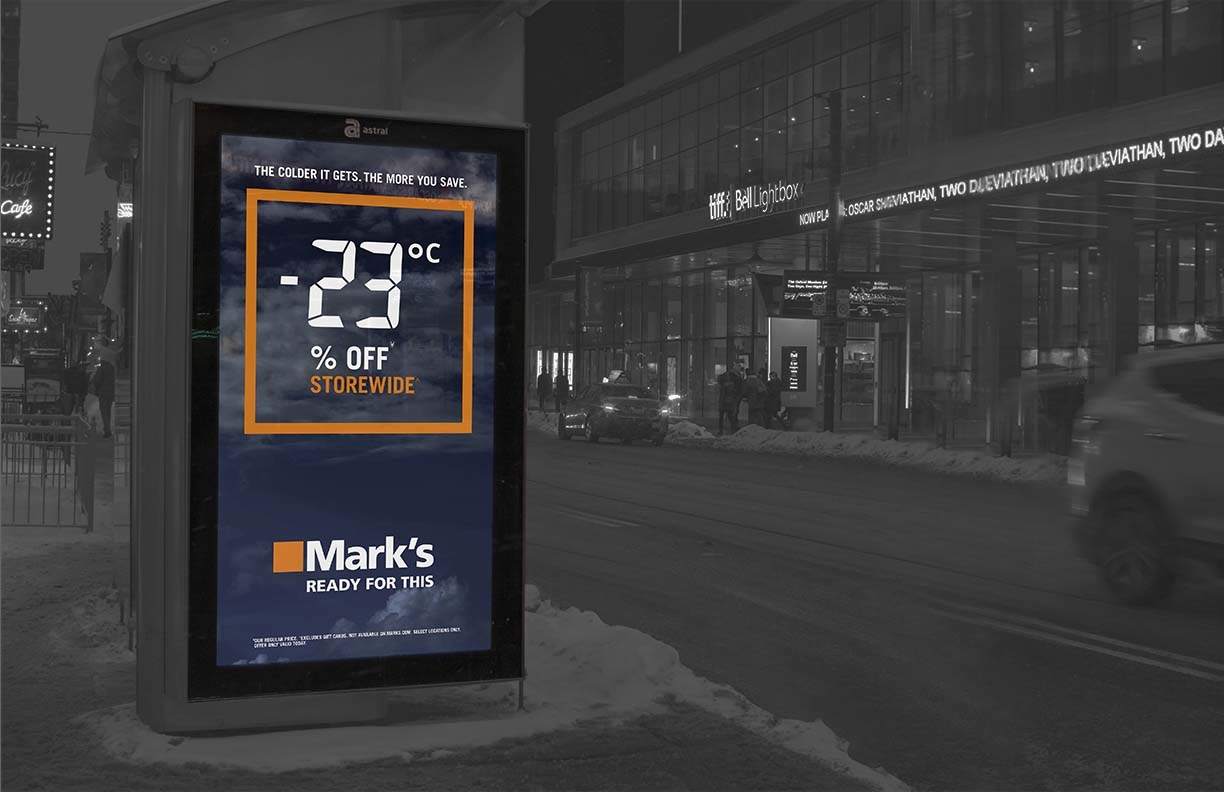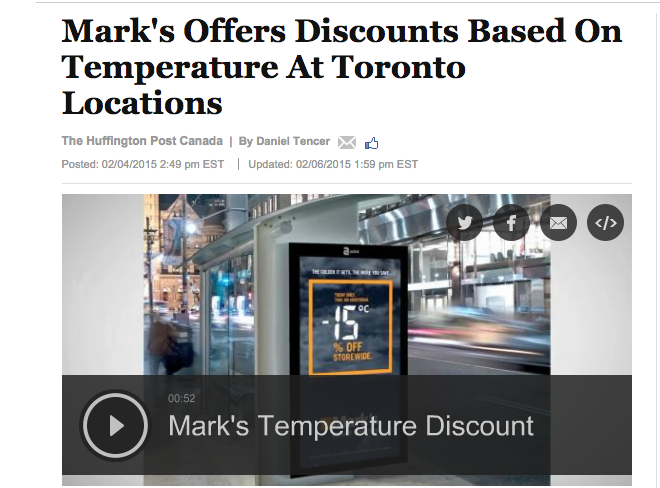Mark’s – Ready for Winter
Best Matching of Message to Medium(s) (SILVER)
Client Credits: Mark’s
VP, Marketing: David Lui
Senior Manager, Marketing Planning: Penney McTaggart-Cowan
Senior VP, Marketing: Frederick Lecoq
AVP, Marketing: Sabrina Lalonde
Campaign Manager: Trudy Fraser
Senior Manager, E-Commerce: Kristine Arcand
Digital Media Manager: Wes Penrose
Media Manager: Julia Shauf
Agency Credits: Sid Lee
Executive Creative DIrector: Jeffrey Da Silva
Executive Creative Director: Tom Koukodimos
Art Director: Barbato Martiniello
Copywriter: Emma Quiroz
VP, Business Growth & Development: Jared Stein
Account Managers: Nicki Franek, Kiara Wilson
Account Coordinator: Sara Teasdale
VP, Strategy: Dustin Rideout
Senior Strategist: Josh Hansen
Print Production: M&H; Graphics
Director, Integrated Production: Karla Ramirez
Project Manager: Phu Pham
Retoucher: John Forbes
Mac Artist: Franco Piane
Media Agency: Astral Out-of-Home
Section I — BASIC INFORMATION
| Business Results Period (Consecutive Months): | February 2 – 22, 2015 |
| Start of Advertising/Communication Effort: | February 2 – 22, 2015 |
| Base Period as a Benchmark: | February 2 – 22, 2015 |
Section II — SITUATION ANALYSIS
a) Overall Assessment
COMBATTING POST-HOLIDAY FATIGUE
In Canada, the months of January and February are spent in a state of dormancy. Aside from the bone-chilling temperatures it reaches during this time of year, people across the nation are still feeling the aftermath of holiday indulgence. In other words, Canadians are full, mall-exhausted, and satisfied with their newly received presents. At the same time, retailers across the country experience significant declines in foot traffic, as shopping for pleasure is not top of mind.
b) Resulting Business Objectives
GETTING SHOPPING-EXHAUSTED CONSUMERS BACK IN STORES
Each year retailers are tasked with the common objective to clear out winter inventory to make way for spring. As the new season begins, the old product must go. It’s a price point war across retailers. Amidst this clearance clutter Mark’s had to find a way to break through with only a sales message.
Typically for Mark’s, post holiday objectives are driven by flyer initiatives to tactically push remaining product. But with an ambitious 2015 business objective to increase comp sales YoY by 10%, the question became whether flyer and low prices alone could achieve the goal. Especially in combat of the challenge at hand: getting shopping-exhausted consumers, who are desensitized to red and yellow sales cues, back into stores.
With this challenge firmly planted in the way of success, the opportunity to demonstrate Mark’s brand purpose – getting Canadians ready for everyday life – and in turn move more urban Canadians into Mark’s stores, became a daunting task to achieve.
c) Annual Media Budget
$100,000 – $200,000
d) Geographic Area
Regional – Toronto
Section III — STRATEGIC THINKING
a) Analysis and Insight
USING THE ELEMENTS TO TRIGGER A PHYSIOLOGICAL NEED.
While Mark’s urban Canadian male target takes pride in shopping for style-correct apparel, a tangible necessity remains the most dominant motivation to visit a store. Following the shopping lethargic post-holiday season, it became even more imperative to provide a pragmatic reason to shop. As such, the strategy had to install an undeniable need if the message was going to get noticed. In order to provide a purpose, however, there was a need to question conventional creative and strategic approaches to clearance messaging that would typically rely on simple push media, product benefits or low prices.
The opportunity lay in leveraging a key and most-relevant insight: weather is the first and most important trigger for the purchase of outerwear. Recognizing this, and being very familiar with the mercurial and extreme Canadian weather, the strategy became clear.
Tying a winter apparel sale to at-the-minute weather would create the incentive needed to break through the saturated market noise by helping Canadian consumers understand what they need and how Mark’s can help
b) Communication Strategy
USING THE MEDIUM AS CONTEXT TO STRENGTHEN THE MESSAGE STRATEGY
With a strong insight to build from, the next step was to determine how the media strategy could help reinforce the connection to weather. It was decided that the most convincing way to use weather to trigger a need was by being present in the middle of the Canadian winter.
In other words, an OOH media strategy would allow the physical experience of the weather to strengthen the message.
It was also determined that running the ads in proximity to key store locations would help ignite immediacy with a simple and easy call-to-action. As such, digital transit shelters became the perfect medium to interplay with the contextual subject matter. The problem, however, was that the technology to feed real-time data in transit shelters (of which the strategy was contingent) didn’t yet exist.
The “Ready for Winter” transit ads challenged the Canadian OOH landscape to become the first ever digital transit ads informed by a live Weather Network feed to determine the sales offering for consumers. As the temperature dropped, so did Mark’s discounts on winter apparel, allowing Canadians to reap the benefits of the coldest month (February) of the year.
Section IV — KEY EXECUTIONAL ELEMENTS
a)Media Used
Digital transit shelters connected to real time weather data gave the sale contextual relevance that consumers could not ignore.

b)Creative Discussion
USING SIMPLICITY TO STAND OUT
The creative strategy was to keep the execution as clean as possible. The concept itself needed to do most of the talking, so both copy and visuals were clear and purposeful. Product was not shown to ensure consumers were motivated to find out more, and instead visual weather cues were used to further drive home the need. Darker background colours helped contrast the orange and white copy so that the message shown bright at all times of the day, while typical sales colours and graphic treatments were intentionally avoided to decrease the risk of blending in to the surrounding noise. What resulted was a clear execution with very strong branding that could not be ignored.
c)Media Discussion
Across the city of Toronto, 29 Mark’s Ready for Winter transit shelters ran for three weeks during the coldest month of the year (Feb 2 – 22), each execution within walking distance to a nearby store.
Section V — BUSINESS RESULTS
a) Sales/Share Results
A NEWSWORTHY CLEARANCE INITIATIVE
Though the campaign ran for only three weeks, and during the aftermath of the holiday wake (Feb 2 – 22), the flaghship stores in Toronto experienced a 21% increase in comp sales YoY, greatly surpassing the ambitious objective of increasing sales by 10%.
Further highlighting the success were the sales differences between other Mark’s stores and the overall category. The 21% increase was an impressive 13% higher than non-participating Ontario Mark’s stores, and nearly four times greater than the national category norms which came in at only 4.7% during the month of February [Footnote 1].
But arguably, the most rewarding results were the 18MM earned media impressions garnered across not only industry outlets, but also respected papers such as the Toronto Star and Huffington Post. In the end, the Mark’s “Ready for Winter” transit shelters challenged Canadian OOH media technology to include real time data, drove far better sales results than Mark’s was aiming for, further proved and established Mark’s purpose of getting Canadians ready for everyday life, and, more importantly, settled the debate on whether promotional initiatives and creativity can live together.



b) Consumption/ Usage Results
n/a
c) Other Pertinent Results
n/a
d) Return on Investment
n/a
Footnote 1: 2015 Retail Sales by NAICS: North American Industry Classification System Canada
Section VI — CAUSE & EFFECT BETWEEN ADVERTISING AND RESULTS
a)General Discussion
n/a
b)Excluding Other Factors
Spending Levels:
n/a
Pricing:
n/a
Distribution Changes:
n/a
Unusual Promotional Activity:
n/a
Other Potential Causes:
SALES OF APPAREL IN CANADA DID NOT PARTICULARLY INCREASE
Statistics Canada released numbers as of “Retail Trade – February 2015” showing a marginal increase of 4.7% in February 2015 over February 2014 sales in clothing stores category (ref: 2015 Retail Sales by NAICS: North American Industry Classification System Canada).